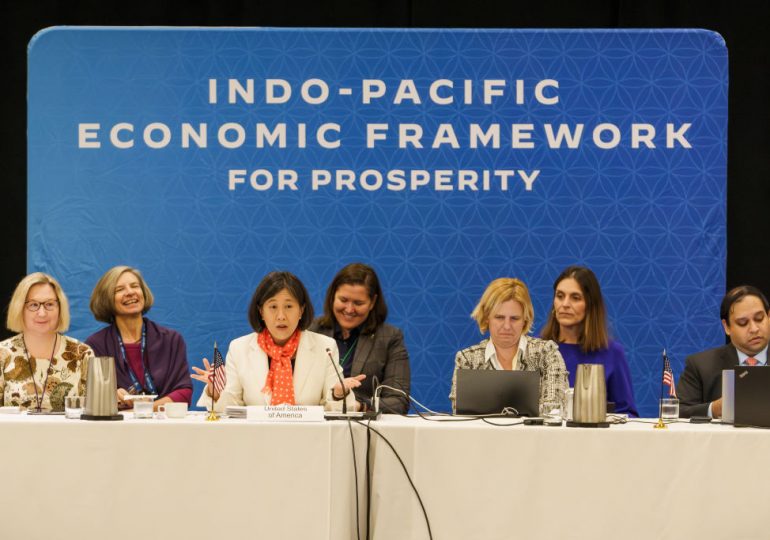President Joe Biden is nurturing economic ties this week with Asia, but he’s not signing any trade deals at a regional summit in San Francisco.
Read More: Biden Calls Xi a ‘Dictator’ Right After Praising Progress in Repairing U.S.-China Relationship
[time-brightcove not-tgx=”true”]
This fact — no trade deals — reveals a lot about the status of U.S. politics, the evolving global economy and the Biden administration’s own ambitions. U.S. negotiators say they’re progressing on finalizing agreements with 13 other countries on parts of the Indo-Pacific Economic Framework. The operative word is “framework” as that label allows Biden to bypass Congress in reaching agreements in IPEF (pronounced EYE-pef).
“It’s a framework because the administration wanted to have something it could do by executive agreement,” said Robert Holleyman, a former deputy U.S. trade representative.
Many U.S. voters have negative opinions about trade deals that they see as having caused industrial job loss, a prevailing sentiment in the 2016 presidential election that carries over to the upcoming 2024 race. IPEF can partially fill that gap by sidestepping some of the domestic politics while also addressing issues such as supply chains and climate change that have historically been outside trade deals. Here’s a breakdown of the framework and the progress being announced at the Asia-Pacific Economic Cooperation leaders’ meeting.
What is IPEF?
Biden formally announced IPEF during a May 2022 trip to Tokyo. It has four major pillars: supply chains, climate, anti-corruption and trade.
“We’re writing the new rules for the 21st century economy,” Biden said when the initiative was unveiled. But unlike a traditional trade deal, the framework is not about expanding market access or laying out penalties for unfair practices.
The trade pillar is being overseen by U.S. Trade Representative Katherine Tai, while the other three are under Commerce Secretary Gina Raimondo. The U.S. and its partners are expected to announce agreements on supply chains, climate and anti-corruption, but negotiators are still working through parts of the trade pillar, according to people who are tracking the talks.
Which countries are in IPEF?
Besides the U.S., there are 13 members that represent 40% of global gross domestic product. The other members are Australia, Brunei, Fiji, India, Indonesia, Japan, South Korea, Malaysia, New Zealand, Philippines, Singapore, Thailand and Vietnam, according to the U.S. government.
What is in the agreements
Matthew Goodman, director of the Greenberg Center for Geoeconomic Studies at the Council on Foreign Relations, said before the leaders’ meeting that the White House has been “signaling” the terms of the various agreements. Each pillar is negotiated separately.
On trade, there will be some language on agriculture and expanding trade relationships. But the major issues of labor, environmental standards and rules for digital companies are still being negotiated.
Sen. Sherrod Brown, D-Ohio, objected to the trade pillar in part because of a lack of worker protections, prompting the Biden administration to not move forward with an agreement on the issue. Brown is up for reelection next year in an increasingly Republican state that identifies with its industrial heritage.
“Instead of negotiating trade deals behind closed doors, we should be working to strengthen enforcement so that American workers can compete on a level playing field,” Brown said.
The U.S. government has suggested there will be an agreement on the other three pillars, but those would also be in the early stages.
Why trade deals are unpopular
It’s simple: Voters say past trade deals caused the loss of factory jobs that hollowed out their hometowns and the Biden administration agrees.
The 2016 presidential election was a landmark event on rejecting trade pacts. Both party’s candidates, Republican Donald Trump and Democrat Hillary Clinton, walked away from the Trans-Pacific Partnership. Then President Trump revised the existing trade deal with Canada and Mexico, while raising taxes on a range of imports and starting a trade skirmish with China.
Trade deals offered the prospect of cheaper goods and geopolitical stability, a prospect that was also somewhat undermined as the coronavirus pandemic exposed fragile supply chains that were overly dependent on China. Biden has sought to find alternatives to Chinese factories while maintaining the tariffs that Trump imposed on Chinese goods.
Read More: Xi and Biden Must Overcome the Hawks to Forge a New U.S.–China Relationship
In a June speech, Tai criticized past trade deals.
“If we look at what those agreements did, we see the ways in which they contributed to the very problems we are now trying to address,” said Tai, emphasizing that “our new approach to trade recognizes people as more than just consumers, but also producers —the workers, wage earners, providers, and community members that comprise a vibrant middle class.”
Trade deals also take years to negotiate and even longer to finalize across presidential administrations. The last new trade deal was signed with South Korea in 2007 and went into force in 2012. By comparison, IPEF is moving a speedy clip as agreements are being announced after less than two years.
Leave a comment
















